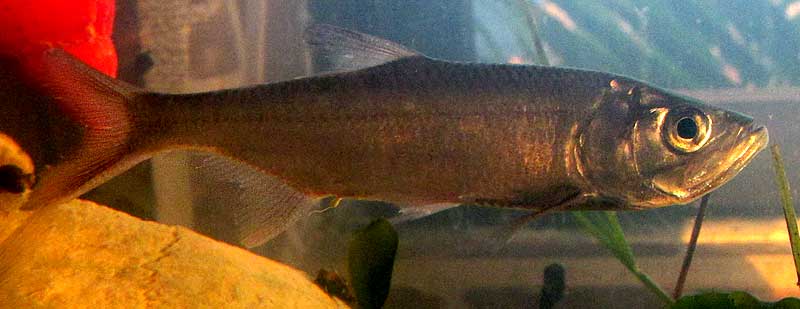Excerpts from Jim Conrad's
Naturalist Newsletter

from the March 15, 2015 Newsletter issued from Río Lagartos, on the Yucatan Peninsula's northern coast (~N21.60°, ~W88.16°), Yucatán state, MÉXICO
TARPON FINGERLINGS
In a shallow pool next to the road into Río Lagartos, next to shallow lagoons and mangrove swamps, three-inch-long (8cm), slender, silvery fish were darting about. "Minnows," a Northerner might call them. Some boys from San Felipe thought they were interesting enough to coax into a plastic bag and carry to the restaurant/tour-office building, where our aquarium has become a local attraction. You can see one in the aquarium above.
When Diego saw the little fish he got excited because he offers catch-and-release fly-fishing for Tarpon in the estuary, and he recognized the fish as young Tarpon, MEGALOPS ATLANTICUS, called Sábalos in Spanish. You might be interested in pictures of big Tarpon caught by Diego's customers at http://www.flyfishingyucatan.com/.
Part of what caused Diego's excitement is that, despite Tarpon being considered on the great "game fishes," not much is known about Tarpon spawning. One reason for this lack of information is that Tarpon aren't considered commercially valuable as food fish, so little effort has been made to understand them.
Tarpon regularly inhabit both sides of the Atlantic Ocean, from Senegal to the Congo on the Atlantic's eastern shores, to the Gulf of Mexico and the Caribbean on the western shores. However, Tarpon range widely, and have been caught as far north as Nova Scotia and as far south as Argentina. Tarpon routinely migrate through the Panama Canal, but haven't been shown to breed in the Pacific Ocean. They tolerate wide ranges in salinity throughout their lives and eat almost anything dead or alive, and their movements seem to be limited mainly by water temperatures. They prefer water temperatures of 72 to 82°F (22-28°C). Below 60°F (15.5°C) they become inactive, and temperatures below 40°F (4.5°C) can be lethal. They're thought to spawn in the Yucatan Channel, which is the strait between Mexico and Cuba connecting the Caribbean with the Gulf of Mexico.
Once the Tarpon were recognized and admired, they were released. It's unlawful to keep Tarpon in aquaria here.